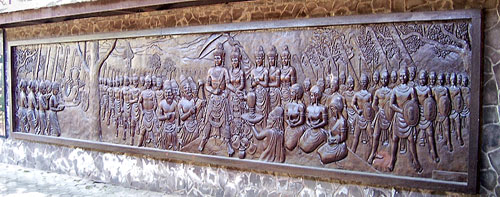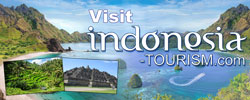Tourism Destinatons
About Mojokerto Regency

The
Symbol of Mojokerto Regency
The Symbol of Mojokerto Regency has specified based on PERDA
Mojokerto Municipality number 3 in 26 Aprils 1971 by DPRGR
Mojokerto municipality.
The Form of Symbol
1. Leaf Symbol is form of angular shield 5 (five).
2. Green symbol with yellow peripheral has painted paddy
and cotton.
3. In the middle of leaf symbol is describes:
Tree MAJA picture have its rooting is 12, its fruit is 9
and its surging blue line branch is 3.
4. Under the leaf symbol, there is a band picture write
down “Mojokerto City"
The Meaning of Form and Color Symbol
1. Shield is the defense
2. The 5 angle is depicting the Unity States Philosophy
of Republic Of Indonesia PANCASILA
3. Green symbol with yellow peripheral has painted paddy
and cotton symbolize of prosperity.
4. Blue line symbolize the Brantas river that flow in the
side of town and as one of prosperity infrastructure.
5. Green color is symbolize the prosperity
6. Tree MAJA picture have its rooting is 12, its fruit is
9 and its 3 branch mean 1293 reminding to forming of Majapahit
Kingdom.
The History of Mojokerto Regency
The history of the Government of Mojokerto regency has strong
related with the history of Mojopahit Kingdom, which during
the feather had led by a king named Hayam Wuruk in 1350
- 1389 with his great Prime Ministry Gajah Mada.
Mojopahit Kingdom is a big state, located in Brantas River,
Delta area and Brangkal River, and has a strong defense
that is enough Taft in facing the colonial team. At that
time, Canggu area as the port area is the gateway of all
activities of commerce traffic (logistics). For the fluency
of communications and transportation, Mojopahit made road
to connect the port area of Canggu with center capital.
Mojokerto regency as the center goverment of Mojopahit,
now, it still leaves many evidences, for example the naming
of Prajurit Kulon, Magersari, Suronatan, Sentanan, etc.
Year to year, hence the history of Mojopahit has under the
Netherlands colonization. At the Dutch Government, Mojokerto
regency formed as Stage menthe based a governor J. Van Limburgstirum
decision on 20 Junes 1918, Staatblad in 1918 Numbers 324.
Then at Japan epoch, Mojokerto regency was having status,
as ‘sidi’. Sie Cok and Sie Sangikat who had
its proxy beside proxy from Mojokerto area held the Government.
In 1945, Mojokerto regency is East Java front line defense,
where the Division Headquarter I had led by the commander
of Sungkono division. At that moment, their teams were face
to Colonials team and had backward reached Mojokerto. As
struggle bases area, Mojokerto regency along with the whole
society, have shown the spirit of their struggle to faced
the colonial attacked which would return the colonization
government in Indonesia.
In memorize the heroism and patriotism spirit at our country,
and to commemorate the warrior day in 10 Novembers, then
it had carried out a traditional hiking of Mojokerto - Surabaya.
Beside that, to memorize the spirit of the struggle, it
had built a monument of proclamation that stands in the
centre of Mojokerto great waves in which has changed for
government building. Mojokerto regency with intensive effort
from the Mojokerto regency Government has become LVRI building
/ 1945 Struggle Building.
In 1945 - 1950, the Mojokerto regency Government has executes
the government become the part of Mojokerto regency government
and governed by a proxy mayor beside the area national committee.
At that time, the Mojokerto Regent has double duty to become
a mayor and the member of Indonesia national committee.
In 1950, East Java country had became the part of indonesia,
hence based on invitors Nomor 17 The year 1950, about Pembentukan
the small area in East Java / Central Java / West Java province
then confirmed as Township based on the law number 1 of
1957.
The law number 18 of 1965 its nomenclatures had turn into
Mojokerto municipality then based on the law number 5 of
1974 was change again become area municipality level II
Mojokerto, as part of expansion region of Gerbangkertosusila.
Since release of PP number 47 of 1982 about the Boundary
Modification of Area Municipality Region Level of II Mojokerto,
region wide of Mojokerto municipality become 16, 46 KM2,
which consist of two district regions, that is Magersari
district and Prajurit Kulon with 18 Countryside / Sub-district.
Then with the existence of the law number 22 of 1999, about
area government, Area Municipality Level II MOJOKERTO like
other areas changed nomenclature to become the Government
of Town Mojokerto.
The forming of The Government of Mojokerto city through
a history process being had started with status as Staadgemeente,
and based on result of research, area municipality level
II Mojokerto number HK. 66 of 1982 specify that the anniversary
of Mojokerto regency be on 20 Junes.
Geographically
Town Region Mojokerto reside in 7°33 ' LS and 122°28
' BT with regional boundaries as follows:
North side: Brantas River
Eastside: Puri District Mojokerto regency
Side South: Sooko and Puri District Mojokerto regency
Westside: Sooko District Mojokerto regency
Topographically
Mojokerto Region regency lay in height about 22 meters from
sea level and inclination of soil 0% - 3%. Thereby can be
showed that Mojokerto city have to surface of soil that
is relatively flat, so that the river flow channel become
relative slowness and this thing has quicken the superficiality
that finally arise the pond at various part of towns in
the rain.
Soil type
The soil type in Mojokerto regency consisted of alluvial
( 6274%) and grumosol ( 3726%). From the condition soil
type in Mojokerto regency is good enough soil to effort
for agriculture, because the soil consisted of sediment
of mixed clay with smooth sand, cushy with retainer energy
of good enough water and containing of enough mineral for
flora.
Soil Ability
The soil in Mojokerto regency has backing by:
Depth of soil effectiveness cover overall of Mojokerto city
namely depth of 90 cm and more. That region show good region,
which has good soil for growth of crop root.
Soil texture as a whole has fine texture class / ductile
had determined by the comparison of sand faction, dirt and
clay.
Tough drainage showing stripper and frequently saturated
soil to water content and speed diffuse it water from surface
of soil, reach 1575,44 Ha ( 95,68 % ) have never suffused
and 71,095 Ha ( 4,317 % ) suffused periodical.
Almost never has erosion of Mojokerto regency because its
soil type is alluvial and grumosol.
Hydrology
Mojokerto regency is DAS Brantas area along the length of
3,50 km, DAS BRANGKAL river along the length of 2,25 km
and Sadar river along the length of 2 kms, which its benefit
is useful for resident life, especially for irrigation of
agriculture.
Climate
Climate in Mojokerto regency has distinguished with the
existence of the rains and dry season with rainfall average
of 10, 58 mm. The rainfall influence both direct and indirect
is cropping pattern namely usage intensity of soil and available
of irrigation water. While, temperature reach 220 - 310
with dampness of air 74,3 - 84,8 Mb / day and wind velocity
average of shifting 3,88 - 6,88 knots / month.
Description of Land Use
Usage aspect of soil / farm in Mojokerto can depict the
domination of usage between areas woke up and it have not
woke up and its spreading in 1999 usages of soil / farm
in Mojokerto earn which describe as follows (based on Mojokerto
regency broadly 16,46 km2):
Settlement = 44,14 %
Education = 0,79 %
Industry = 4,34 %
Agriculture = 41,76 %
Effort For Commerce = 2,76 %
White collars = 2,46 %
Health = 0,66 %
Supporting Facilities For Communication= 2,40 %
Grave / mausoleum = 0,04 %
Field events = 0,15 %
Observance = 0,21 %
Others = 0,24 %
(Data source : BPN Town Mojokerto)

Kesiman Temple
Kesiman Temple Kesiman Temple is located in Kesiman Tengah village, Pacet district, Mojokerto regency. In Kesiman temple there are only the foot and body part remain. This temple is looks out upon west direction. On its fourth body part, has crafted some relief in Javanese style, medallion, rectangle, and human shape. In medallion, there is animal relief; then in rectangle, there is entertainer. The up stair is located in southwest and southeast side. The under part of stair in southeast is getting broken. The north side wall of the entertainer…
Trowulan Museum Mojokerto
Trowulan Mojokerto One of Trowulan’s central attractions is the new Archaeological Museum, to be found on the western side of the kolam segaran. Officially opened in 1987, it was built for the purpose of displaying and preserving the ever increasing number of historical treasures discovered in the vicinity of the old Majapahit capital. Covering a spacious area of some 57,625 square metres, this new site accommodates the collection of the old Trowulan Museum, as well as the bulk of the stone sculpture which used to be housed in the museum…
Legendary Jolotundo
Jolotundo Temple Jolotundo is like a swimming pool area that located near to Seloliman village, Trawas district, and east slope of Mount Penanggungan. This site is believed has relation with King Airlangga. This temple was prepared for Udayana King from Bali who embraced Gunapriyadharmapatni prince. From their marriage, it was born Airlangga it was build in 997M. According to the story, the water in this temple is the clearest water in the word, and the slope of Bekal Mountain, one of Peak of Penaggungan Mountain, Seloliman, Trawas. Its location is…
Jolotundo Site
Jolotundo There are two sites on Mt Penanggungan which can be visited quite easily, that is the bathing places of Jolotundo and Belahan, it located on the western and eastern sides of the mountain respectively. Jolotundo is like a swimming pool area that located near to Seloliman village, Trawas district, and east slope of Mount Penanggungan. This site is believed has relation with King Airlangga. This temple was prepared for Udayana King from Bali who embraced Gunapriyadharmapatni prince. From their marriage, it was born Airlangga it was build in 997M.…







